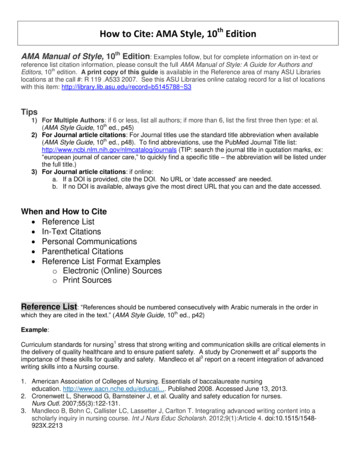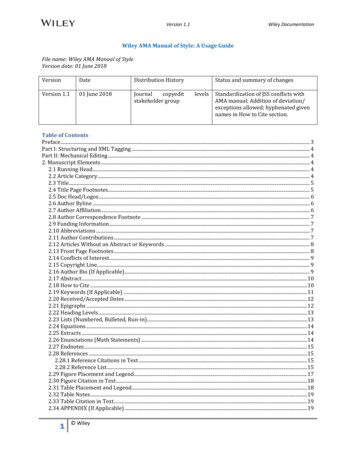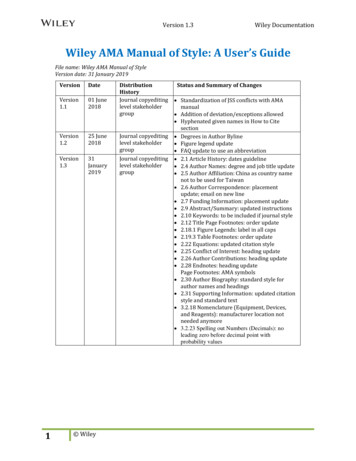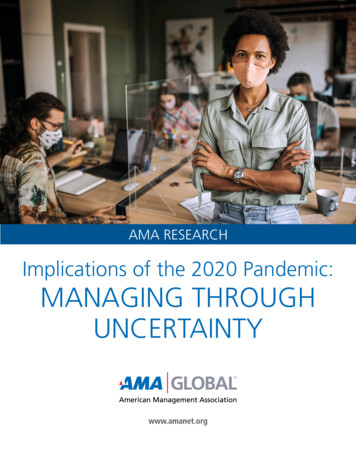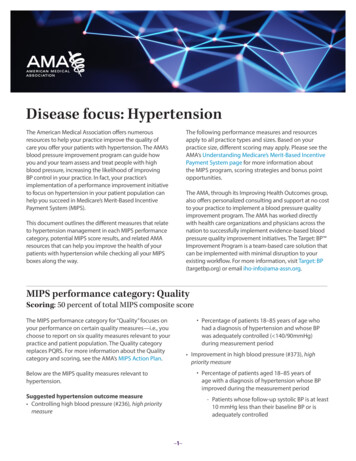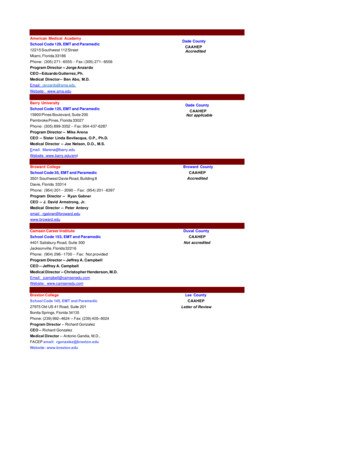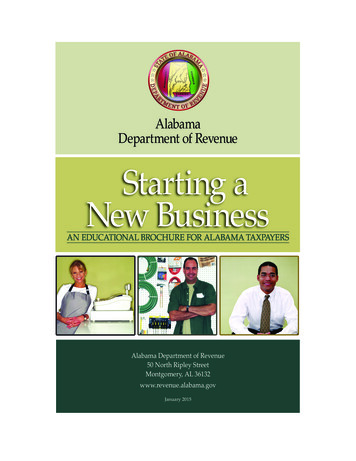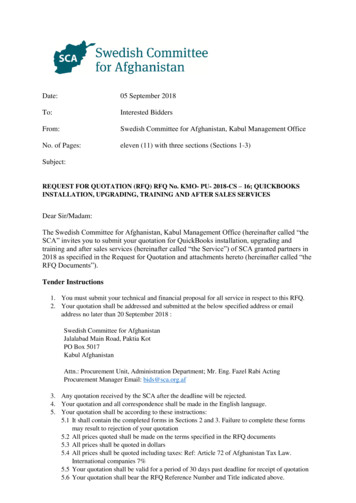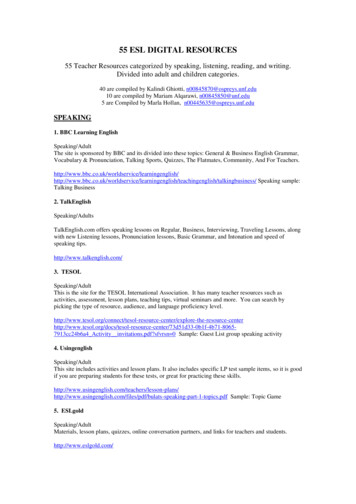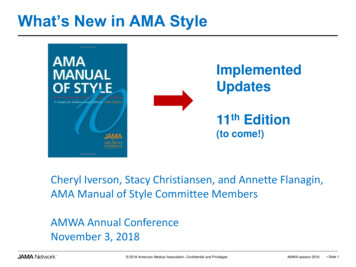
Transcription
What’s New in AMA StyleImplementedUpdates11th Edition(to come!)Cheryl Iverson, Stacy Christiansen, and Annette Flanagin,AMA Manual of Style Committee MembersAMWA Annual ConferenceNovember 3, 2018 2018 American Medical Association. Confidential and Privileged.AMWA session 2018 Slide 1
Presenter Disclosures We are paid employees (SC, AF) or contractors (CI) for theAmerican Medical Association, which owns the AMA Manual ofStyle. SC and AF are unpaid members of the Council of ScienceEditors short course faculty. SC serves on several CSEcommittees, also unpaid. AF is an unpaid board member of STM: InternationalAssociation of of Scientific, Technical and Medical Publishers Other AMA Manual of Style Committee Members include LaurenFischer, Phil Fontanarosa, Tracy Frey, Brenda Gregoline,Edward Livingston, and Connie Manno (all editorial staff of theJAMA Network). 2018 American Medical Association. Confidential and Privileged.AMWA session 2018 Slide 2
Updates to be reviewed in this session The stylebook revision process Statistics Manuscript Preparation items References: changes andupdated examples Tables and figures: titles,headers, and axis labels Grammar, Punctuation, andAbbreviations updates Mathematical Composition Electronic editing and workflow Updates to Resources andPublishing Glossary Corrections and pervasive errors Updates on authorship policies Data Sharing Statement Preferred and Correct Usage: Updates on public and opennew terms and usage examplesaccess Nomenclature: Updates How to access stylebookincluding drugs and geneticsupdates Units of Measure and Numbers 2018 American Medical Association. Confidential and Privileged.AMWA session 2018 Slide 3
Manuscript PreparationIn line with contemporary usage, we have removedthe hyphen in email and now lowercase internet andwebsite. In text: “Send me an email.” In titles: “How PhysiciansUse Email” The hyphen is retained in other e- compounds (eg, ecigarette, e-book). In titles, capping of words that follow e- will be on thefirst letter of the word that follows: “State Restrictionson e-Cigarette Use” website, webcam, webcast, webpage, the web 2018 American Medical Association. Confidential and Privileged.AMWA session 2018 Slide 4
Manuscript Prep: Death DaggerDiscontinuation of the death daggerThe convention of using a dagger (†) next to a name inan article byline, connected to a footnote to indicate adeceased author, has been discontinued. If desired,this information can be included in the Acknowledgmentsection at the end of the article. For example:Additional Information: Coauthor John Doe, MD, diedJanuary 30, 2018. 2018 American Medical Association. Confidential and Privileged.AMWA session 2018 Slide 5
References: Publisher LocationPublisher location for books and reports will nolonger be required in the next edition.In the 11th edition, AMA style will no longer recommendincluding the publisher’s location for several reasons: Many publishers have more than 1 location and determining whichlocation is appropriate to include can be challenging Location can be difficult to determine if looking at an online resource(eg, an e-book) Publisher location is not a necessary piece of information inretrieving the reference. 2018 American Medical Association. Confidential and Privileged.AMWA session 2018 Slide 6
Publishers in Book CitationsFormerly:Iverson C, Christiansen S, Flanagin A, et al. AMA Manualof Style: A Guide for Authors and Editors. 10th ed. NewYork, NY: Oxford University Press; 2007.Future style:Iverson C, Christiansen S, Flanagin A, et al. AMA Manualof Style: A Guide for Authors and Editors. 11th ed. OxfordUniversity Press; 2019. 2018 American Medical Association. Confidential and Privileged.AMWA session 2018 Slide 7
DOIs in Reference ListWhen a DOI is included for journal references, noperiod follows The ability to easily and accurately copy and pasteDOIs is important. Because of this, a period should not be included afterthe DOI; the risk of the period becoming a part of theDOI itself is too great and would create problems withlinking. Online linking is one of the key reasons to have a DOI.1. Cassel CK. Can retail clinics transform healthcare? JAMA. Published online April 12, 2018.doi:10.1001/jama.2018.2172 2018 American Medical Association. Confidential and Privileged.AMWA session 2018 Slide 8
URLs in Reference ListIn reference lists, the URL will be the last item,following dates posted/updated/accessed. Noperiod follows it. This style will mirror currentformatting for citations with a DOI.1. Centers for Disease Control and Prevention. MillionHearts: meaningful progress 2012-2016. PublishedMay 2017. Accessed August 9, gfulprogress.pdf 2018 American Medical Association. Confidential and Privileged.AMWA session 2018 Slide 9
Social Media ReferencesFacebook: Mayo Clinic Healthy Living Facebook page. AccessedFebruary 10, 2016. ogram/Twitter: @AMAManual. The human immunodeficiency virus is widelyknown by its abbreviation HIV, to the extent that AMA style no longerrequires the expansion (especially true in the construction“HIV/AIDS”). Posted October 12, 2018. Accessed October 27, 70825076737Blog: Antos D. The percolating proofreader. AMA Style Insider blog.Posted January 14, 2016. Accessed February 10, /status/1050763170825076737 2018 American Medical Association. Confidential and Privileged.AMWA session 2018 Slide 10
Digital ReferencesReferences chapter will include citation guidelines for apps,podcasts, databases, and much more1. The JAMA Network Challenge app. Version 1.2. AmericanMedical Association. Updated April 27, 2016.2. Livingston EH. Editor’s audio summary. JAMA. March 26,2014. Accessed October 4, 2016. 2623. HUGO Gene Nomenclature Committee (HGNC). Human GeneNomenclature database search engine. Accessed March 14,2018. http://www.genenames.org 2018 American Medical Association. Confidential and Privileged.AMWA session 2018 Slide 11
Tables and Figures: Style UpdateChange to sentence-style capitalization in allelements of tables and figures (axis labels, columnheadings)– Current style (cap all major words in col headings): 2018 American Medical Association. Confidential and Privileged.AMWA session 2018 Slide 12
Sentence-Style Caps in Tables (cont)Future style: all elements in sentence style (reducesconfusion about which style to use where, makeslong phrases easier to read) 2018 American Medical Association. Confidential and Privileged.AMWA session 2018 Slide 13
Sentence-Style Caps in Figures Current style Sentence style 2018 American Medical Association. Confidential and Privileged.AMWA session 2018 Slide 14
Grammar UpdateSingular “they” AMA Manual will join other resources, such as The ChicagoManual of Style and AP Stylebook, in permitting use of theyas a singular pronoun when rewriting the sentence as pluralwould be awkward or unclear. [Note: the other manuals saythat rewording usually is possible and always is preferable.]“Every patient should take their medication.” Could be reworded“Patients should take their medication.” This construction can be useful in medical articles inwhich patient identifiability is a concern (eg, removal ofgender-specific pronouns).“The patient was adamant that they were not taking illicitsubstances.” 2018 American Medical Association. Confidential and Privileged.AMWA session 2018 Slide 15
Grammar for Social MediaScientific articles often have a life beyond theirformal full-text publication, including social mediasuch as Twitter and Facebook.Because these posts have strict space limits(Twitter allows just 280 characters) or expectationsof brevity from followers, it is usually not possible, oreven desirable, to strictly adhere to grammar,punctuation, and usage norms.However, some standards are necessary to ensureclarity. 2018 American Medical Association. Confidential and Privileged.AMWA session 2018 Slide 16
Grammar for Social Media (cont)In blogs and social media posts about scientificcontent, aim for the following: Use proper capitalization; capital letters do nottake up more characters than lowercase. Use basic punctuation to help ensure clarity. Avoid texting jargon, such as “U” for “you” or “L8”for “late”; these abbreviations are too colloquial(even, in some cases, regional) and may not bewidely understood. Contractions are appropriate, as are easilyrecognized symbols such as &, , and . 2018 American Medical Association. Confidential and Privileged.AMWA session 2018 Slide 17
Punctuation: When Not to Use HyphensExpanded list of nonhyphenated terms Do not hyphenate modifiers in which a letter or number isthe second element.type 1 diabetesphase 2 study Some combinations of words are commonly read togetheras a unit.amino acid levelslower extremity amputationbone marrow biopsymedical school studentsdeep venous thrombosisopen access journalhealth care system 2018 American Medical Association. Confidential and Privileged.AMWA session 2018 Slide 18
Abbreviations: New EntriesNew abbreviations addedACEIangiotensin-converting enzyme inhibitorACLanterior cruciate ligamentCKDchronic kidney diseaseGWASLGBTQMERSgenome-wide association studylesbian, gay, bisexual, transgender, andqueerMiddle East respiratory syndromeOUDSNVopioid use disordersingle-nucleotide variant 2018 American Medical Association. Confidential and Privileged.AMWA session 2018 Slide 19
Abbreviations: Fellowships RemovedOmission of all fellowship designations Fellowship designations are generally not listed inbylines or elsewhere. These can be difficult to police (incurrent style, what qualifies for inclusion?).Straightforward rules keep things fair, simpler foreditors. FRCP, FRCPC, etc, have been removed from the list ofdegrees Emphasis is on academic degrees. Honorary degreesand other awards (eg, knighthood) are not included. 2018 American Medical Association. Confidential and Privileged.AMWA session 2018 Slide 20
Usage: Terms UpdatedAddition of socioeconomic status 11.12.5 Socioeconomic Status.—Avoid labelingpeople with their socioeconomic status, such as thepoor or the unemployed. Instead, terms such as lowincome and no income are preferred. low-income, limited-income, resource-limited,resource-poor, transitional terms added Use of the terms first world/third world anddeveloped/developing are not recommended asdescriptors when comparing countries or regions. 2018 American Medical Association. Confidential and Privileged.AMWA session 2018 Slide 21
Usage: More TermsAddition of terminology on addiction Avoid use of “alcoholic,” “addict,” “user,” and “abuser” —replace with “she was addicted,” “people with opiateaddiction,” “he abused alcohol,” “alcohol misusedisorder”New additions to correct and preferred usage list nauseous, nauseated foreign-born—replace with specifics, eg, “non-US born” elicit, illicit, solicit alternative, alternate 2018 American Medical Association. Confidential and Privileged.AMWA session 2018 Slide 22
Spelling and Spacing PreferencesSpelling and spacing variations added to Correctand Preferred Usage chapter, with JAMA Networkpreferences (boldface) noted.health care/healthcare/health-caredata set/datasetemail/e-mail/Emailwebsite/Web site/Website 2018 American Medical Association. Confidential and Privileged.AMWA session 2018 Slide 23
Nomenclature: DrugsDrugs: we no longer include manufacturer location In section 15.5 (page 583 in the print), Equipment,Devices, and Reagents, we no longer require theinclusion of the location of the manufacturer. This is soeasy to look up online, should anyone desire morespecific details, that we believe it is not necessary tocontinue to require this. “The 9-valent HPV vaccine (Gardasil 9, Merck & Co)was administered to 5 vaccination cohorts.” “The active medication was 1 mL of triamcinolone(purchased from Bristol-Myers Squibb), 40 mg/mL, forinjection.” 2018 American Medical Association. Confidential and Privileged.AMWA session 2018 Slide 24
Nomenclature: GeneticsGenetics: Discourage use of aliases/nicknames forgenes and proteinsGene symbol Gene descriptionAcceptable expressionTP53The TP53 gene (p53 is the alias;the official term is preferred tothe alias)tumor protein p53 (LiFraumeni syndrome)geneMay be necessary to “dual report” for aliases wellentrenched in use:“ERBB2 (previously HER2/neu)” 2018 American Medical Association. Confidential and Privileged.AMWA session 2018 Slide 25
Nomenclature: Genetics (cont)The Human Genome Variation Society recommendsavoiding the terms mutation and polymorphism, preferringinstead the terms sequence variant, sequence variation,alteration, or allelic variant.In view of this recommendation, single-nucleotide variation(SNV) is now more frequently used instead of SNP (singlenucleotide polymorphism) and may become standard.To aid readers’ understanding during this transition, at firstmention SNV may be used, with SNP in parentheses:“ SNV (formerly SNP) ” 2018 American Medical Association. Confidential and Privileged.AMWA session 2018 Slide 26
Units of Measure: CurrenciesCurrencies will be updated, including AfricandenominationsEthiopian birr (ብር)Ghana cedi (GH )Malawi kwacha (MK)Nigeria naira ( )Uganda shilling (USh)Zimbabwe dollar ( ) 2018 American Medical Association. Confidential and Privileged.AMWA session 2018 Slide 27
Units of Measure: Spacing in TemperaturePer SI convention, we will no longer close updegree symbols in temperature but use a spaceafter the number: temperature of 37.5 C (not 37.5 C or 37.5 C) 2018 American Medical Association. Confidential and Privileged.AMWA session 2018 Slide 28
Numbers: CI Not ExpandedIn the list of abbreviations (Section 14.11, page 504in the print), an asterisk was added after CI toindicate that this abbreviation no longer needs to beexpanded. “Low-quality evidence has shown that risedronatereduces the risk of fragility fractures (hazard ratio, 0.27;95% CI, 0.09-0.83; P .02).” “The primary analysis followed a modified intention-totreat principle and used a 1-sided 95% CI fornoninferiority.” 2018 American Medical Association. Confidential and Privileged.AMWA session 2018 Slide 29
Statistics: Terms UpdatedThe terms multivariable and multivariate are not synonymous, asthe entries in the current Glossary suggest (Chapter 20.9, page881 in the print). To be accurate, multivariable refers to multipleindependent variables for a single outcome (dependent variable).Multivariate refers to 1 or more independent variables for multipleoutcomes. See the Update on the stylebook site. Most clinical studies use a multivariable approach (a singleoutcome) “Using sex-stratified multivariable-adjusted Cox proportionalhazards models, black women and men were more likely todevelop diabetes than white men and women (black women:HR, 2.86 [95% CI, 2.19-3.72]; black men: HR, 1.67 [95% CI,1.28-2.17]).” Diabetes is the single outcome; sex and raceare independent variables. 2018 American Medical Association. Confidential and Privileged.AMWA session 2018 Slide 30
Mathematical Composition: UpdatesUpdate to the chapter to include more examples. To avoid confusion, do not display forms of statisticalanalysis as subscript, such as Pinteraction .001.Better: P .001 for interaction. Thin spaces (a character usually 1 5 or 1 6 the width ofan em dash; the Unicode value for the 1/6 em space is2006) should be used before and after the followingmath symbols used as verbs, conjunctions, or operators: , , , , , , , , , , ·, , , , , Π, Σ, and .When used to describe a quantity, they are closed up:Patient age 30 years. Values were 50 to 25. Whiteblood cell count is expressed as 109/L. 2018 American Medical Association. Confidential and Privileged.AMWA session 2018 Slide 31
Typography, Tagging, DisplayAddition of XML (discussion and tagging examples) XML (extensible markup language) provides rules fornaming and defining parts of a document and theirrelationship with each other. XML uses tags in start-end pairs (such as title Title ofthe Article /title and body /body ) to define theelements in that piece of content. For more on JATS tagging, .1d3/chapter/gen-intro.html. 2018 American Medical Association. Confidential and Privileged.AMWA session 2018 Slide 32
Electronic Editing WorkflowSoftware programs have text editing functionality that allows usersto view edits and track changes. Some newer software programspermit collaborative writing and editing. How authors and editorsrespond to the editing depends on not only the software programbut also the technologies and workflow involved.For example, JAMA Network manuscript editors send editedmanuscripts to authors showing text insertions and deletions andcomments/questions as a PDF file. Authors can respond by usingediting/commenting tools directly on the PDF; by printing it out,marking up the copy, scanning it, and returning via email; or byoutlining corrections and query answers in an email. Authors arealso provided with proofs that are generated programmatically tolook like a composed proof for initial review before finalcomposition and publication. 2018 American Medical Association. Confidential and Privileged.AMWA session 2018 Slide 33
XML-Based Workflow (cont)The JAMA Network journals have created efficiencies by using a“single-source” workflow. In this process, content remains in theoriginal document format (eg, Word) and is stored with the XMLfile and related content (eg, supplemental files, multimedia).Because XML is the basis of this workflow and content, anychanges required (before, during, or even after publication) mustbe made in the source document and new XML generated. If anindividual output is corrected but the source file is not, any currentand future versions of that content will not reflect the change.For example, if a correction is made to the HTML version only,and the source file is not updated, the PDF will not contain theupdated content. 2018 American Medical Association. Confidential and Privileged.AMWA session 2018 Slide 34
Guidelines Added to Resources SectionSection on Guidelines added to Resources chapter Committee on Publication Ethics(COPE). https://www.publicationethics.org EQUATOR Network. https://www.equator-network.org International Committee of Medical Journal Editors (ICMJE)Uniform Requirements. https://www.icmje.org World Association of Medical Editors (WAME) policystatements. http://www.wame.org/policies-and-resources 2018 American Medical Association. Confidential and Privileged.AMWA session 2018 Slide 35
Publishing Glossary: UpdatesMany additions and deletions, especially to reflecttechnological updates to publishing, documentcreation and retrieval, and communication Removal of CD-ROM, CPU, DOS, elite type, fax, harddisk, internet, keyboard, LAN, mainframe, mouse, pageproof, password, PC, program, RTF, storage Addition of cloud, ghost writer, IP address, JATS,landscape, NISO, open access, scholar’s margin,stylesheet, STEM, thin space, Unicode 2018 American Medical Association. Confidential and Privileged.AMWA session 2018 Slide 36
Editorial Assessment: Corrections Corrections are important to theintegrity of the publishedliterature Errors range from relativelyminor and inconsequential errorsto major errors that invalidate theresults and the underlyingscience Christiansen S, Flanagin A. Correcting themedical literature: “to err is human, to correctdivine.” JAMA. 2017;318(9):804-805.doi:10.1001/jama.2017.11833 2018 American Medical Association. Confidential and Privileged.AMWA session 2018 Slide 37
Editorial Assessment: CorrectionsMinor ErrorSubstantive ErrorsInconsequential error (eg, atypographical error that couldresult in misunderstanding)Errors requiring a Correction notice(eg, author name misspelled,incorrect numbers, important missinginformation)Article corrected onlineCorrection notice publishedAn indication of correction anddate of correction are added tothe article information (HTMLand PDF versions)The article is corrected online withindication of correction and date ofcorrection added to the articleinformation (HTML and PDFversions)No Correction noticeThe Correction notice and correctedarticle are reciprocally linked 2018 American Medical Association. Confidential and Privileged.AMWA session 2018 Slide 38
Pervasive errorsInadvertent errors that result in the need to correct importantor numerous data and information in the abstract, text, tables,and figures (eg, a coding error)No major changesChange and validChange andinvalidIf none of theconclusions orinterpretations areaffected and there areno statistically significantchanges in the resultsIf the direction orsignificance of theresults, interpretations,and conclusionschange—and thescience is still validIf the results,interpretations, andconclusionschange—and thescience is no longervalidLetter of explanationand CorrectionRetraction andReplacementRetraction 2018 American Medical Association. Confidential and Privileged.AMWA session 2018 Slide 39
New Option: Retraction and Replacement Why? – 21% of retractions are due to error, not misconduct This mechanism allows authors to do the right thing without thestigma or penalties associated with retractions When? - Used judiciously – for cases of inadvertent pervasiveerrors that when corrected change the findings, interpretations,and/or conclusions And after review – the science is still considered valid How? - Requires a Letter of explanation from all authors An itemization of all errors and corrections Replacement article retains the original article DOI and anyusage and citation metrics No “retraction” or do not use watermark 2018 American Medical Association. Confidential and Privileged.AMWA session 2018 Slide 40
Retraction and ReplacementArticle InformationRetraction and Replacement: This article was retracted and replaced on August 23, 2018, to fix errorsthroughout the article and tables (see Supplement 2 or the retracted article with errors highlighted andSupplement 3 for the replacement article with corrections highlighted). 2018 American Medical Association. Confidential and Privileged.AMWA session 2018 Slide 41
Retraction and Replacement 2018 American Medical Association. Confidential and Privileged.AMWA session 2018 Slide 42
Ethical and Legal Updates: Authorship Contributor: anyone – an author, a collaborator, writer,assistant, etc Author: meets all 4 ICJME criteria and completes an authorshipform.– Byline author: Author name in byline– Nonbyline author: author name not in byline – listed at theend of article Collaborator: nonauthor member of a formal group whocontributes significantly Group author: a group of individuals, usually involvingmulticenter study investigators, members of working groups, andofficial or self-appointed expert boards, panels, or committees,who wish to display a group name to indicate authorship. 2018 American Medical Association. Confidential and Privileged.AMWA session 2018 Slide 43
Ethical and Legal Updates: AuthorshipAuthors et al – who is who? 2018 American Medical Association. Confidential and Privileged.AMWA session 2018 Slide 44
Shared Authorship Positions It has become increasingly common for authors to request“co-first authorship,” “co-senior authorship,” or some otherindication of equal contribution. Journals accept indication of co-first authorship – butsomeone’s name will need to go first in the byline or authorlist. Requests for “co-first authorship” beyond 3 or 4 namedauthors may not be justifiable. This information can be displayed in the Acknowledgmentjust before the list of author contributions, such as “Drs Brown and Jones served as co-first authors andcontributed equally to the work.” 2018 American Medical Association. Confidential and Privileged.AMWA session 2018 Slide 45
Corresponding Authors Requests for having up to 2 individuals listed as correspondingauthors on a published article will be considered if justified. In such cases, 1 author must be designated as the primary pointof contact who will serve the primary corresponding author For all communications with the journal Will review an edited manuscript/proof Make decisions regarding release of information to the newsmedia Handle any postpublication inquires, errors/corrections, etc Two can be listed in the Corresponding Author section of thepublished article, but the primary corresponding author will belisted first. 2018 American Medical Association. Confidential and Privileged.AMWA session 2018 Slide 46
Formatting 2 Corresponding AuthorsFrom same institutionCorresponding Authors: Jie Qiao, MD, PhD (jie.qiao@263.net), andTianpei Hong, MD, PhD (tpho66@bjmu.edu.cn), Peking University ThirdHospital, 49 N Garden Rd, Beijing 100191, China.From same institution, different departmentsCorresponding Authors: Jie Qiao, MD, PhD, Center of ReproductiveMedicine (jie.qiao@263.net), and Tianpei Hong, MD, PhD, Department ofEndocrinology and Metabolism (tpho66@bjmu.edu.cn), Peking UniversityThird Hospital, 49 N Garden Rd, Beijing 100191, China.From different institutionsCorresponding Authors: Linhong Wang, PhD, Chinese Center for DiseaseControl and Prevention, Beijing 100050, China (linhong@chinawch.org.cn);Yonghua Hu, MD, Department of Epidemiology and Biostatistics, School ofPublic Health, Peking University, Beijing 100191, China(yhhu@bjmu.edu.cn). 2018 American Medical Association. Confidential and Privileged.AMWA session 2018 Slide 47
Intellectual Property Updates: Data Sharing Many research sponsors and government agencies havepolicies to encourage data transparency and sharing. In 2017, the International Committee of Medical JournalEditors (ICMJE) issued a statement on sharing clinical trialdata that indicates new requirements for sharing of dataunderlying the results presented in published clinical trials.(JAMA. 2017;317[24]:2491–2492. doi:10.1001/jama.2017.6514) Beginning in July 2018, data sharing statements arerequired for reports of RCTs; optional for other study types Statements are required, but actual sharing is not yetrequired 2018 American Medical Association. Confidential and Privileged.AMWA session 2018 Slide 48
Data Sharing Statement – Questions for Authors Will data be shared? Yes or no (with optional explanation If yes, what types of data– Deidentified participant data– Participant data with identifiers– Data dictionary How shared and where to access? When will data be shared? Will supporting documents be shared– Trial protocol and statistical analysis plan– Statistical/analytic code– Informed consent document Who can access? For what types of analyses? By whichmechanisms (eg, with investigator support or a signedagreement)? Any restrictions on access or use? 2018 American Medical Association. Confidential and Privileged.AMWA session 2018 Slide 49
Data Sharing Statement: JAMA ExampleData Sharing Statement: See Supplement 4. (This is a PDF) 2018 American Medical Association. Confidential and Privileged.AMWA session 2018 Slide 50
Data Sharing Statement – Other Examples New England Journal of Medicine: Links to a PDF– A data sharing statement provided by the authors isavailable with the full text of this article at NEJM.org. Annals of Internal Medicine: Included in ArticleInformation section– Reproducible Research Statement: Studyprotocol: Available from Dr. Miller(email, dmiller@wakehealth.edu). Statistical code and dataset: Available to approved persons through agreement withthe authors (email, dmiller@wakehealth.edu). 2018 American Medical Association. Confidential and Privileged.AMWA session 2018 Slide 51
Public access and open access Public access: free access to content, permitting users toread, download, print, search, and link to content, but withcopyright restrictions and limitations on sharing and reuse. Many journals make research articles free public access at6, 12, or 24 months after publication; required for USfunded research since 2013 Many journals deposit research articles in publicrepositories (eg, PMC) for free public access at 6,12, or 24months after publication; some permit posting beforepublication in preprint servers or repositories 2018 American Medical Association. Confidential and Privileged.AMWA session 2018 Slide 52
Open access Open access: Users have unrestricted access withouttypical copyright restrictions and can freely read,download, copy, distribute, print, search, or link to fulltext of articles, and reuse and modify the content in partor whole, without permission, for any lawful purposeprovided that authors are properly acknowledged andcited. Typically requires an author processing charge (APC)– Range: 1200 to 5000– Clinical medicine journal average: 2093– Multidisciplinary journal average: 3464– Data from Pay It Forward report for the year 2013 UC-Pay-It-Forward-Final-Report.rev .7.18.16.pdf 2018 American Medical Association. Confidential and Privileged.AMWA session 2018 Slide 53
Differences between public and open accessPublic AccessFree to readOpen AccessFree to read, reuse, modifywithout permissionNo author feeAuthor processing charge(APC)Delayed access (6, 12, 24Immediate access withmonths after publication)publicationTransfer of copyright orUse of CC license; authorpublication license to journal retains copyrightRequired by NIHRequired by some funders,eg, Gates, Wellcome Trust 2018
Grammar Update Singular “they” AMA Manual will join other resources, such as The Chicago Manual of Style and AP Stylebook, in permitting use of they as a singular pronoun when rewriting the sentence as plural would be awkward or unclear. [Note: the other manuals say that
